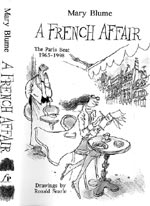The International Herald Tribune’s most celebrated feature writer
has brought out a luminous collection of her essays covering the
Paris beat between 1965 and 1998. “A French Affair” — a sample of her wise, heart-rending, unsentimental... trademark
wit — describes French culture and tradition seen through the
eyes of Simone de Beauvoir and V.S. Pritchett, among others, and
explores impossible topics like love, death, and anarchy through
her interviews with Truffaut, Renoir, Resnais, Wertmuller, Peter
Brook and Fellini.
Mary Blume might define creativity the way she described Bergman’s
movies — as “a place of tenderness where there is no villain and everyone is forgiven.” She draws
out Fellini on the regenerative quality of creativity and quotes
him as saying: “I don’t think God was unhappy when He was creating
all the things he is said to have done.”
There are memorably measured summations of character or period.
One jewel is a tribute to Simone Signoret: “When someone treasured
dies, it is as if time should stop for a moment and life should
skip a beat.” Her essay on the 1945-46 period also ranks high:
“It was a time of privation and great joy and discovery — of jazz and blue jeans, nylon stockings, parachutes (excellent
for wedding dresses) and [...] GIs who brought them.” In a 1989
interview, she reports that countless people have written to photographer
Robert Doisneau to say that they or their parents were that famous
couple embracing outside the Hôtel de Ville; he always writes
back and tells each one that he or she is right.
Mary’s reserve, cropped golden hair and thin frame could “fit
in” easily on any French street, but she’s always felt like an
outsider and hated it. Yet, she says the fascination of countryside
as near as one hour’s drive from Paris beats the boredom of anything
you’d see within the same distance outside of New York City. “You couldn’t even hit Poughkeepsie.”
As a student in New York City, it never crossed her mind to be
a journalist. Her father was a businessman, her mother was a housewife
and “they were inspiring only in that they kept talking about
Europe.” During summers off from college, she took cultural tours
abroad with her parents visiting cathedrals and museums.” She
spent “her life” reading and majored in English. She couldn’t
get a job because she couldn’t type. The only field open to her
was journalism.
Mary wanted to be in Europe and came to Paris looking for work.
The last place she tried was the Herald Tribune. There was no such thing as a copy girl. But the New York Times’
arrival edition “scared” the Tribune, so they were on the look
out for fresh talent. She hadn’t even been on a school paper,
but they still asked her to write a couple of stories on spec’.
Assuming rejection, she was about to go to a travel agency to
book a flight back to the States when the editors called and asked
her to write two articles a week for 100F a piece and re-write
the fashion copy for an extra 100F. That was in 1960.
“It was always a quirky paper,” she says, “Unusual. Unpredictable.
It is less so now. Buddy Weiss, our editor in the ’70s, called
it ‘an international paper that speaks with American accents.’
That’s a good definition. Now we’ve become an international paper
with no accent. The word, ‘product’ is used a lot but I don’t
know what that means. It used to be a nippy little roadster; now
it’s a stretch limo.”
Mary is regularly told she has the best job in journalism — freedom
to choose her own subject and never having one turned down. She
is, of course, insatiably curious. Indeed, when you interview
her she can’t help interviewing you back She says, “You have to be very alert and not make people feel uncomfortable. To be a listener and not an inquisitor. But I certainly don’t
write about politics. I figured they’d just do a number on me.
Other people might do a number on me but they’d be more subtle.”
The variety of stuff she’s done is wide — but it doesn’t include
the sports page — and she says she can’t write for the financial
page because “I don’t know what a derivative is.”
When she began writing from Paris, it was mostly for the women’s
pages and the readership was mostly American. Now it is 40% American.
“We must keep that in mind when we refer to the adorable little
corner bakery; it must amuse the French.”
“A French Affair” can be compared to Mary’s idea of the genius
of French stores — “always measured profusion: Ali Baba reviewed by Descartes.” Her legacy is that she has managed to combine the best of America
— freshness of spirit — with the best of France, the elegantly
turned phrase of the skeptic. Her readers will agree with Sir
Peter Ustinov who said that she is one of a sacred battalion of
Americans with whom Europeans feel a kindred spirit — inquisitive
and crackling with intelligence and grace.









